 | –≠–ª–µ–∫—Ç—Ä–æ–Ω–Ω—ã–π –∫–æ–º–ø–æ–Ω–µ–Ω—Ç: HAL566 | –°–∫–∞—á–∞—Ç—å:  PDF PDF  ZIP ZIP |
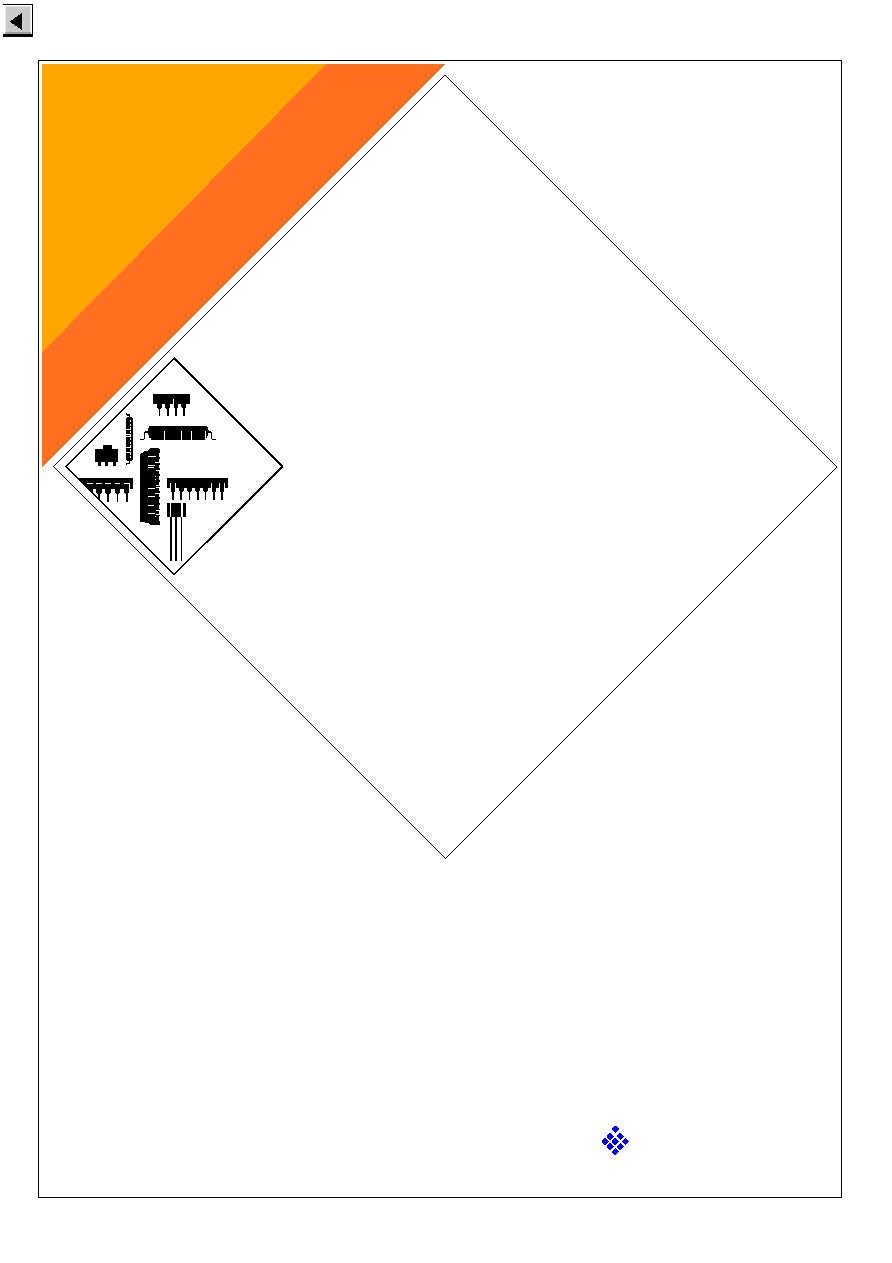
HAL556, HAL560,
HAL566
Two-Wire Hall Effect
Edition Aug. 3, 2000
6251-425-2DS
MICRONAS
MICRONAS
Sensor Family

HAL55x, HAL56x
2
Micronas
Contents
Page
Section
Title
3
1.
Introduction
3
1.1.
Features
3
1.2.
Family Overview
4
1.3.
Marking Code
4
1.4.
Operating Junction Temperature Range
4
1.5.
Hall Sensor Package Codes
4
1.6.
Solderability
5
2.
Functional Description
6
3.
Specifications
6
3.1.
Outline Dimensions
6
3.2.
Dimensions of Sensitive Area
6
3.3.
Positions of Sensitive Areas
7
3.4.
Absolute Maximum Ratings
7
3.5.
Recommended Operating Conditions
8
3.6.
Electrical Characteristics
9
3.7.
Magnetic Characteristics Overview
12
4.
Type Descriptions
12
4.1.
HAL 556
14
4.2.
HAL 560
16
4.3.
HAL 566
18
5.
Application Notes
18
5.1.
Application Circuit
18
5.2.
Extended Operating Conditions
18
5.3.
Start-up Behavior
19
5.4.
Ambient Temperature
19
5.5.
EMC and ESD
20
6.
Data Sheet History

HAL55x, HAL56x
3
Micronas
Two-Wire Hall Effect Sensor Family
in CMOS technology
Release Notes: Revision bars indicate significant
changes to the previous edition.
1. Introduction
This sensor family consists of different two-wire Hall
switches produced in CMOS technology. All sensors
change the current consumption depending on the ex-
ternal magnetic field and require only two wires between
sensor and evaluation circuit. The sensors of this family
differ in the magnetic switching behavior and switching
points.
The sensors include a temperature-compensated Hall
plate with active offset compensation, a comparator, and
a current source. The comparator compares the actual
magnetic flux through the Hall plate (Hall voltage) with
the fixed reference values (switching points). According-
ly, the current source is switched on (high current
consumption) or off (low current consumption).
The active offset compensation leads to constant mag-
netic characteristics in the full supply voltage and tem-
perature range. In addition, the magnetic parameters
are robust against mechanical stress effects.
The sensors are designed for industrial and automotive
applications and operate with supply voltages from 4 V
to 24 V in the junction temperature range from ≠40
∞
C up
to 170
∞
C. All sensors are available in the SMD-package
SOT-89B and in the leaded version TO-92UA.
1.1. Features:
≠ current output for two-wire applications
≠ junction temperature range from ≠40
∞
C up to 170
∞
C.
≠ operates from 4 V to 24 V supply voltage
≠ operates with static magnetic fields and dynamic mag-
netic fields up to 10 kHz
≠ switching offset compensation at typically 145 kHz
≠ overvoltage and reverse-voltage protection
≠ magnetic characteristics are robust against mechani-
cal stress effects
≠ constant magnetic switching points over a wide supply
voltage range
≠ the decrease of magnetic flux density caused by rising
temperature in the sensor system is compensated by
a built-in negative temperature coefficient of the mag-
netic characteristics
≠ ideal sensor for applications in extreme automotive
and industrial environments
≠ EMC corresponding to DIN 40839
1.2. Family Overview
The types differ according to the mode of switching and
the magnetic switching points.
Type
Switching
Behavior
Sensitivity
see
Page
556
unipolar
very high
12
560
unipolar
inverted
low
14
566
unipolar
inverted
very high
16
Unipolar Switching Sensors:
The sensor turns to high current consumption with the
magnetic south pole on the branded side of the package
and turns to low consumption if the magnetic field is
removed. The sensor does not respond to the magnetic
north pole on the branded side.
Unipolar Inverted Switching Sensors:
The sensor turns to low current consumption with the
magnetic south pole on the branded side of the package
and turns to high consumption if the magnetic field is
removed. The sensor does not respond to the magnetic
north pole on the branded side.

HAL55x, HAL56x
4
Micronas
1.3. Marking Code
All Hall sensors have a marking on the package surface
(branded side). This marking includes the name of the
sensor and the temperature range.
Type
Temperature Range
A
K
E
HAL556
556A
556K
556E
HAL560
560A
560K
560E
HAL566
566A
566K
566E
1.4. Operating Junction Temperature Range
The Hall sensors from Micronas are specified to the chip
temperature (junction temperature T
J
).
A: T
J
= ≠40
∞
C to +170
∞
C
K: T
J
= ≠40
∞
C to +140
∞
C
E: T
J
= ≠40
∞
C to +100
∞
C
Note: Due to the high power dissipation at high current
consumption, there is a difference between the ambient
temperature (T
A
) and junction temperature. Please refer
section 5.4. on page 19 for details.
1.5. Hall Sensor Package Codes
Type: 556, 560, or 566
HAL XXXPA-T
Temperature Range: A, K, or E
Package: SF for SOT-89B
UA for TO-92UA
Type: 556
Package: TO-92UA
Temperature Range: T
J
= ≠40
∞
C to +100
∞
C
Example: HAL 556UA-E
Hall sensors are available in a wide variety of packaging
versions and quantities. For more detailed information,
please refer to the brochure: "Ordering Codes for Hall
Sensors".
1.6. Solderability
all packages: according to IEC68-2-58
During soldering reflow processing and manual rework-
ing, a component body temperature of 260
∞
C should not
be exceeded.
Components stored in the original packaging should
provide a shelf life of at least 12 months, starting from the
date code printed on the labels, even in environments as
extreme as 40
∞
C and 90% relative humidity.
Fig. 1≠1: Pin configuration
GND
2
1
V
DD
NC
3
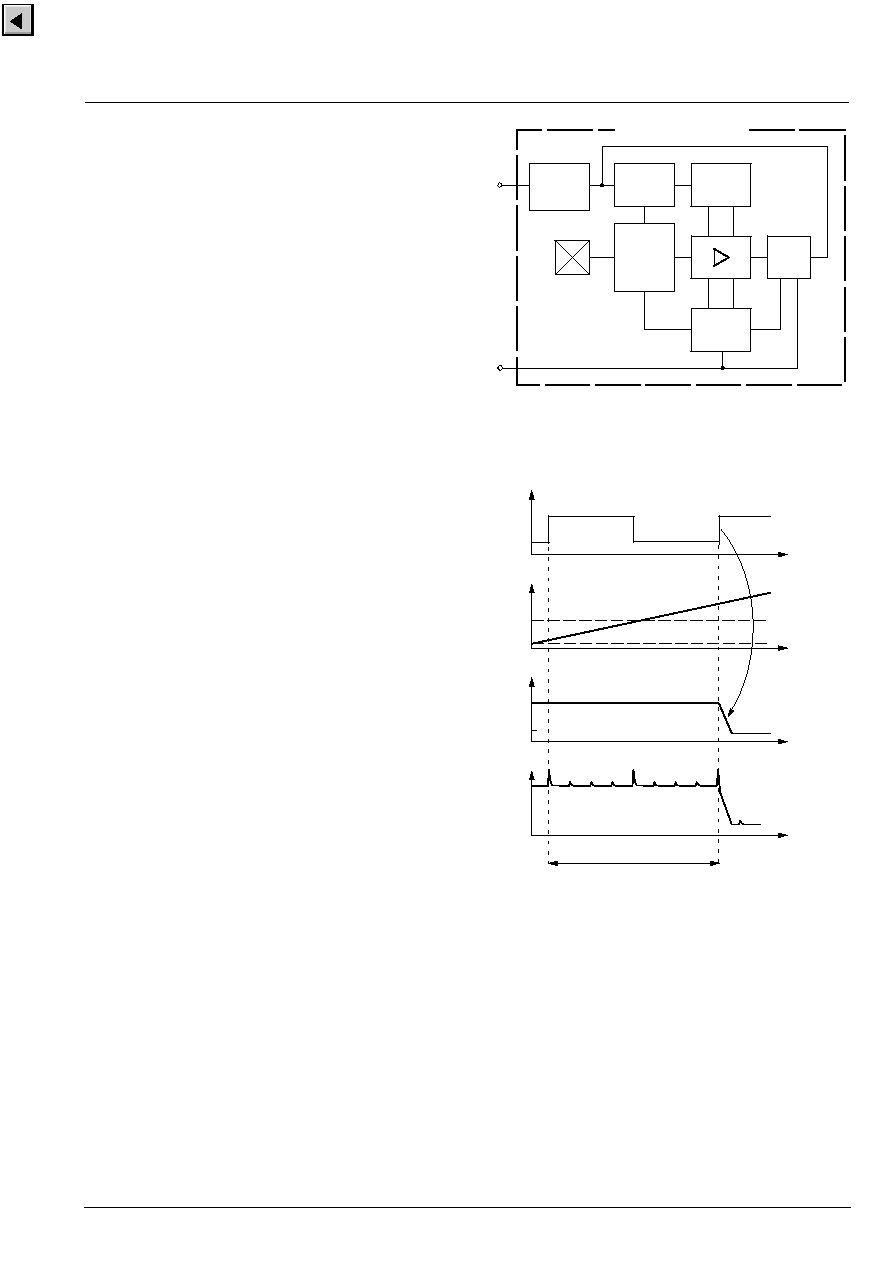
HAL55x, HAL56x
5
Micronas
2. Functional Description
The HAL 55x, HAL 56x two-wire sensors are monolithic
integrated circuits which switch in response to magnetic
fields. If a magnetic field with flux lines perpendicular to
the sensitive area is applied to the sensor, the biased
Hall plate forces a Hall voltage proportional to this field.
The Hall voltage is compared with the actual threshold
level in the comparator. The temperature-dependent
bias increases the supply voltage of the Hall plates and
adjusts the switching points to the decreasing induction
of magnets at higher temperatures.
If the magnetic field exceeds the threshold levels, the
current source switches to the corresponding state. In
the low current consumption state, the current source is
switched off and the current consumption is caused only
by the current through the Hall sensor. In the high current
consumption state, the current source is switched on
and the current consumption is caused by the current
through the Hall sensor and the current source. The
built-in hysteresis eliminates oscillation and provides
switching behavior of the output signal without bounc-
ing.
Magnetic offset caused by mechanical stress is com-
pensated for by using the "switching offset compensa-
tion technique". An internal oscillator provides a two-
phase clock. In each phase, the current is forced through
the Hall plate in a different direction, and the Hall voltage
is measured. At the end of the two phases, the Hall volt-
ages are averaged and thereby the offset voltages are
eliminated. The average value is compared with the
fixed switching points. Subsequently, the current con-
sumption switches to the corresponding state. The
amount of time elapsed from crossing the magnetic
switching level to switching of the current level can vary
between zero and 1/f
osc
.
Shunt protection devices clamp voltage peaks at the
V
DD
-pin together with external series resistors. Reverse
current is limited at the V
DD
-pin by an internal series
resistor up to ≠15 V. No external protection diode is
needed for reverse voltages ranging from 0 V to ≠15 V.
Fig. 2≠1: HAL 55x, HAL 56x block diagram
Temperature
Dependent
Bias
Switch
Hysteresis
Control
Comparator
Current
Source
V
DD
1
Clock
Hall Plate
GND
2
HAL 55x, HAL 56x
Reverse
Voltage &
Overvoltage
Protection
t
I
DDlow
I
DD
1/f
osc
= 6.9
µ
s
I
DDhigh
B
B
OFF
f
osc
t
t
t
I
DD
t
B
ON
Fig. 2≠2: Timing diagram (example: HAL 56x)
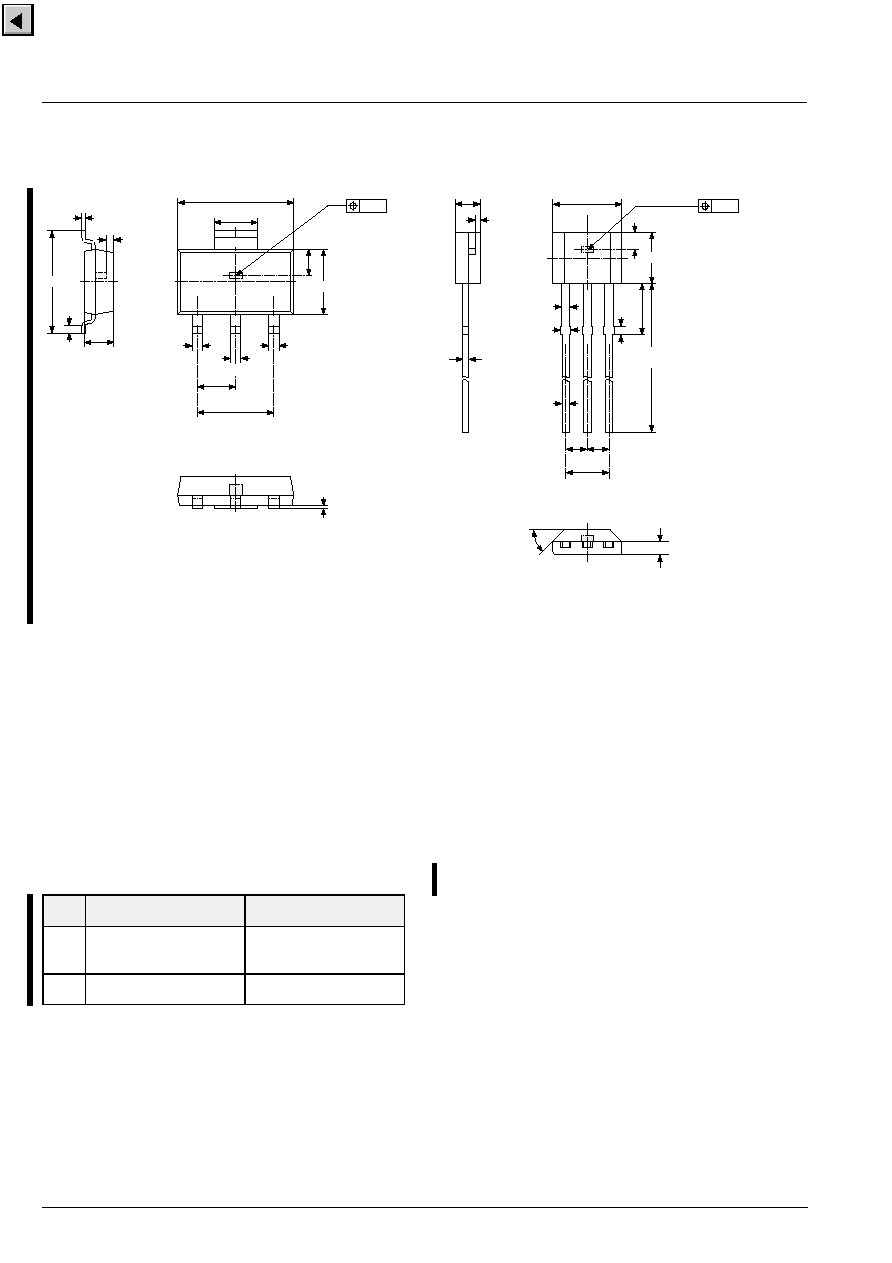
HAL55x, HAL56x
6
Micronas
3. Specifications
3.1. Outline Dimensions
Fig. 3≠1:
Plastic Small Outline Transistor Package
(SOT-89B)
Weight approximately 0.035 g
Dimensions in mm
4.55
1.7
min.
0.25
2.55
0.4
0.4
0.4
1.5
3.0
0.06
±
0.04
branded side
SPGS0022-5-A3/2E
y
1
2
3
4
±
0.2
0.15
0.3
2
0.2
sensitive area
top view
1.15
3.2. Dimensions of Sensitive Area
0.25 mm x 0.12 mm
3.3. Positions of Sensitive Areas
SOT-89B
TO-92UA
x
center of
the package
center of
the package
y
0.85 mm nominal
0.9 mm nominal
Fig. 3≠2:
Plastic Transistor Single Outline Package
(TO-92UA)
Weight approximately 0.12 g
Dimensions in mm
0.75
±
0.2
3.1
±
0.2
0.55
branded side
0.36
0.8
0.3
45
∞
y
14.0
min.
1.27
1.27
2.54
1
2
3
0.42
4.06
±
0.1
3.05
±
0.1
0.48
SPGS7002-9-A/2E
0.4
sensitive area
1.5
Note: For all package diagrams, a mechanical tolerance
of
±
0.05 mm applies to all dimensions where no tolerance
is explicitly given.
The improvement of the TO-92UA package with the re-
duced tolerances will be introduced end of 2001.

HAL55x, HAL56x
7
Micronas
3.4. Absolute Maximum Ratings
Symbol
Parameter
Pin No.
Min.
Max.
Unit
V
DD
Supply Voltage
1
≠15
1) 2)
28
2)
V
I
DDZ
Supply Current through
Protection Device
1
≠50
2)
≠200
3)
50
2)
200
3)
mA
mA
T
S
Storage Temperature Range
≠65
150
∞
C
T
J
Junction Temperature Range
≠40
≠40
150
170
4)
∞
C
1)
≠18 V with a 100
series resistor at pin 1 (≠16 V with a 30
series resistor)
2)
as long as T
J
max
is not exceeded
2)
with a 220
series resistance at pin 1 corresponding to test circuit 1 (see Fig. 5≠3)
3)
t < 2 ms
4)
t < 1000 h
Stresses beyond those listed in the "Absolute Maximum Ratings" may cause permanent damage to the device. This
is a stress rating only. Functional operation of the device at these or any other conditions beyond those indicated in the
"Recommended Operating Conditions/Characteristics" of this specification is not implied. Exposure to absolute maxi-
mum ratings conditions for extended periods may affect device reliability.
3.5. Recommended Operating Conditions
Symbol
Parameter
Pin No.
Min.
Max.
Unit
V
DD
Supply Voltage
1
4
24
V
T
A
Ambient Temperature for continuos
operation
≠40
≠40
85
1)
125
2)
∞
C
∞
C
t
on
Supply Time for pulsed mode
30
≠
µ
s
1)
when using the "A" type or the "K" type and V
DD
16 V
2)
when using the "A" type and V
DD
13.2 V
Note: Due to the high power dissipation at high current consumption, there is a difference between the ambient temper-
ature (T
A
) and junction temperature. The power dissipation can be reduced by repeatedly switching the supply voltage
on and off (pulse mode). Please refer to section 5.4. on page 19 for details.

HAL55x, HAL56x
8
Micronas
3.6. Electrical Characteristics at T
J
= ≠40
∞
C to +170
∞
C , V
DD
= 4 V to 24 V, as not otherwise specified in Conditions
Typical Characteristics for T
J
= 25
∞
C and V
DD
= 12 V
Symbol
Parameter
Pin No.
Min.
Typ.
Max.
Unit
Conditions
I
DDlow
Low Current Consumption
over Temperature Range
1
2
3.3
5
mA
I
DDhigh
High Current Consumption
over Temperature Range
1
12
14.3
17
mA
V
DDZ
Overvoltage Protection
at Supply
1
≠
28.5
32
V
I
DD
= 25 mA,
T
J
= 25
∞
C,
t = 20 ms
f
osc
Internal Oscillator
Chopper Frequency
≠
90
145
≠
kHz
T
J
= 25
∞
C
f
osc
Internal Oscillator Chopper Fre-
quency over Temperature Range
≠
75
145
≠
kHz
t
en(O)
Enable Time of Output after
Setting of V
DD
1
20
30
µ
s
1)
t
r
Output Rise Time
1
0.4
1.6
µ
s
V
DD
= 12 V, R
s
= 30
t
f
Output Fall Time
1
0.4
1.6
µ
s
V
DD
= 12 V, R
s
= 30
R
thJSB
case
SOT-89B
Thermal Resistance Junction
to Substrate Backside
≠
≠
150
200
K/W
Fiberglass Substrate
30 mm x 10 mm x 1.5mm,
pad size see Fig. 3≠3
R
thJA
case
TO-92UA
Thermal Resistance Junction
to Soldering Point
≠
≠
150
200
K/W
1)
B > B
ON
+ 2 mT or B < B
OFF
≠ 2 mT for HAL 55x, B > B
OFF
+ 2 mT or B < B
ON
≠ 2 mT for HAL 56x
Fig. 3≠3: Recommended pad size SOT-89B
Dimensions in mm
5.0
2.0
2.0
1.0

HAL55x, HAL56x
9
Micronas
3.7. Magnetic Characteristics Overview at T
J
= ≠40
∞
C to +170
∞
C, V
DD
= 4 V to 24 V,
Typical Characteristics for V
DD
= 12 V
Magnetic flux density values of switching points.
Positive flux density values refer to the magnetic south pole at the branded side of the package.
Sensor
Parameter
On point B
ON
Off point B
OFF
Hysteresis B
HYS
Unit
Switching Type
T
J
Min.
Typ.
Max.
Min.
Typ.
Max.
Min.
Typ.
Max.
HAL 556
≠40
∞
C
3.4
6.3
7.7
2.1
4.2
5.9
0.8
2.1
3
mT
unipolar
25
∞
C
3.4
6
7.4
2
3.8
5.7
0.5
1.8
2.8
mT
100
∞
C
3.2
5.5
7.2
1.9
3.7
5.7
0.3
1.8
2.8
mT
170
∞
C
2.8
5
7.6
1
3.5
6.2
0.2
1.5
3.2
mT
HAL 560
≠40
∞
C
41
46.5
52
47
53
59
4
6.5
10
mT
unipolar
25
∞
C
41
46.6
52
46
52.5
58.5
3
6
9
mT
inverted
100
∞
C
41
45.7
52
45
41.1
57.5
2
5.4
8
mT
170
∞
C
38
44.2
50
42
49
55.5
2
4.8
8
mT
HAL 566
≠40
∞
C
2.1
4
5.9
3.4
6
7.7
0.8
2
2.8
mT
unipolar
25
∞
C
2
3.9
5.7
3.4
5.9
7.2
0.5
2
2.7
mT
inverted
100
∞
C
1.85
3.8
5.7
3.25
5.6
7
0.3
1.8
2.6
mT
170
∞
C
1
3.4
6.3
2.2
4.8
7.6
0.2
1.4
3
mT
Note: For detailed descriptions of the individual types, see pages 12 and following.
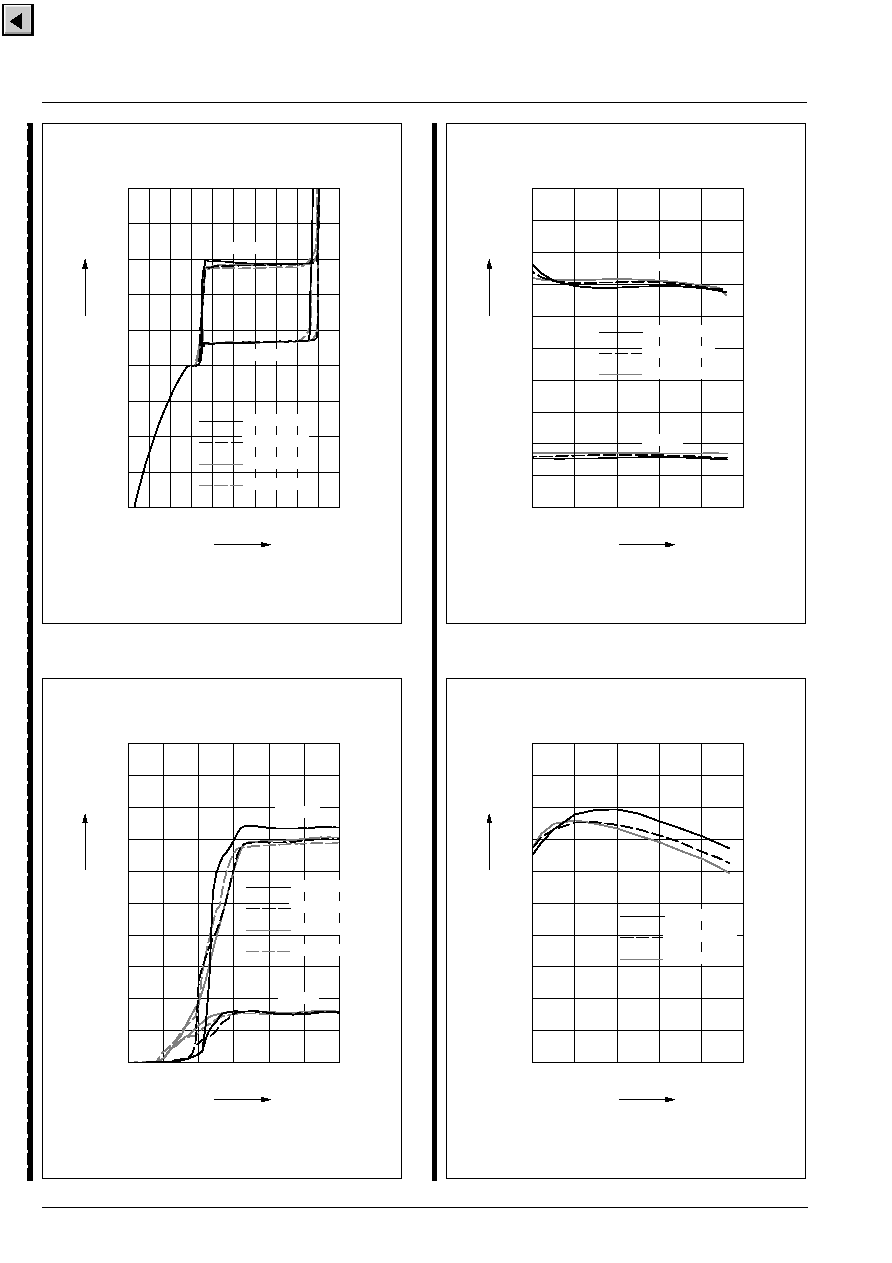
HAL55x, HAL56x
10
Micronas
≠20
≠15
≠10
≠5
0
5
10
15
20
≠15≠10 ≠5 0
5
10 15 20 25 30 35 V
mA
V
DD
I
DD
T
A
= ≠40
∞
C
T
A
= 25
∞
C
T
A
= 100
∞
C
25
HAL 55x, HAL 56x
Fig. 3≠4: Typical current consumption
versus supply voltage
I
DDlow
I
DDhigh
T
A
= 170
∞
C
0
2
4
6
8
10
12
14
16
18
20
0
1
2
3
4
5
6 V
mA
V
DD
I
DD
HAL 55x, HAL 56x
Fig. 3≠5: Typical current consumption
versus supply voltage
I
DDlow
I
DDhigh
T
A
= ≠40
∞
C
T
A
= 25
∞
C
T
A
= 100
∞
C
T
A
= 170
∞
C
0
2
4
6
8
10
12
14
16
18
20
≠50
0
50
100
150
200
∞
C
mA
T
A
I
DD
Fig. 3≠6: Typical current consumption
versus ambient temperature
HAL 55x, HAL 56x
I
DDhigh
I
DDlow
V
DD
= 4 V
V
DD
= 12 V
V
DD
= 24 V
0
20
40
60
80
100
120
140
160
180
200
≠50
0
50
100
150
200
∞
C
kHz
T
A
f
osc
Fig. 3≠7: Typ. internal chopper frequency
versus ambient temperature
HAL 55x, HAL 56x
V
DD
= 4 V
V
DD
= 12 V
V
DD
= 24 V
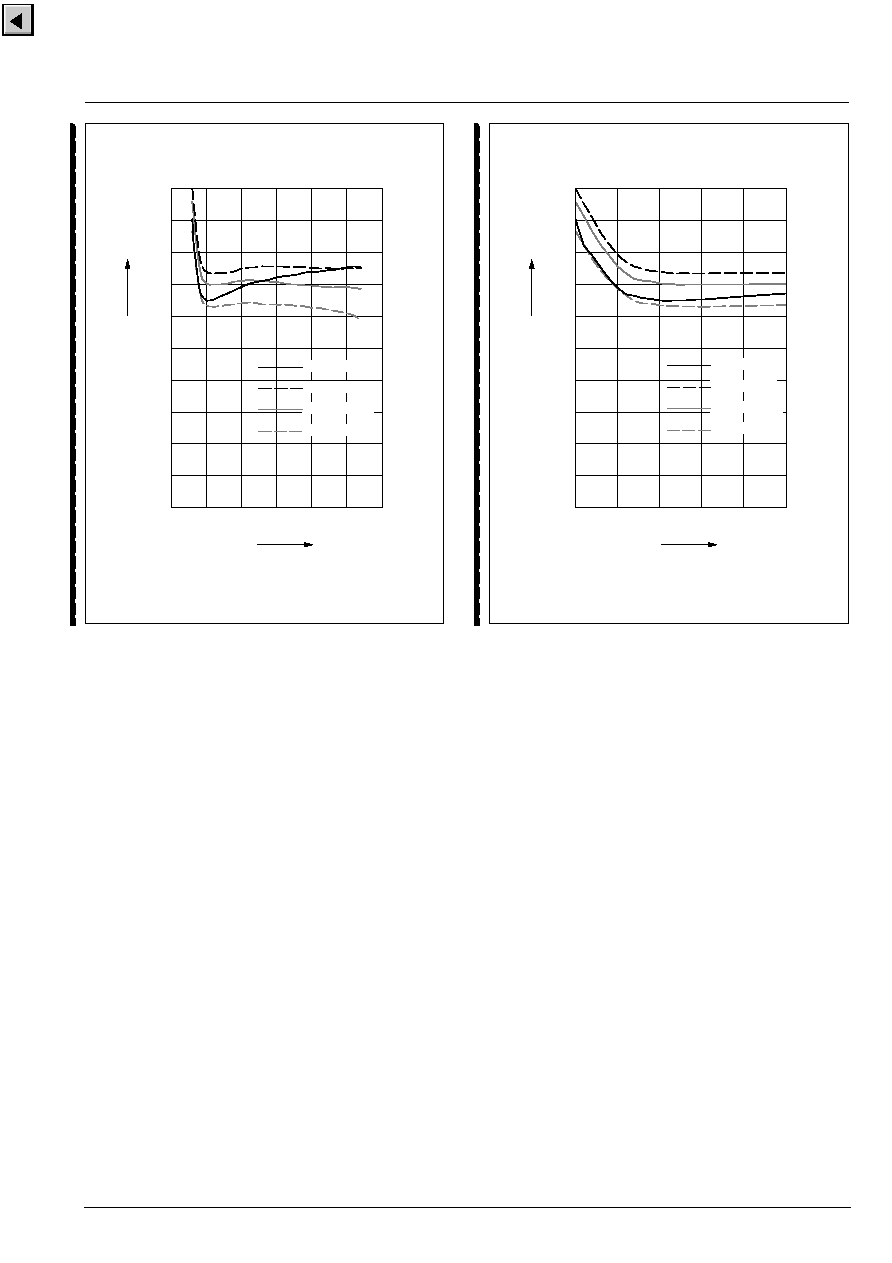
HAL55x, HAL56x
11
Micronas
0
20
40
60
80
100
120
140
160
180
200
0
5
10
15
20
25
30 V
kHz
V
DD
f
osc
Fig. 3≠8: Typ. internal chopper frequency
versus supply voltage
HAL 55x, HAL 56x
T
A
= ≠40
∞
C
T
A
= 25
∞
C
T
A
= 100
∞
C
T
A
= 170
∞
C
0
20
40
60
80
100
120
140
160
180
200
3
4
5
6
7
8 V
kHz
V
DD
f
osc
Fig. 3≠9: Typ. internal chopper frequency
versus supply voltage
HAL 55x, HAL 56x
T
A
= ≠40
∞
C
T
A
= 25
∞
C
T
A
= 100
∞
C
T
A
= 170
∞
C

HAL556
12
Micronas
4. Type Description
4.1. HAL 556
The HAL 556 is a very sensitive unipolar switching sen-
sor (see Fig. 4≠1).
The sensor turns to high current consumption with the
magnetic south pole on the branded side of the package
and turns to low current consumption if the magnetic
field is removed. It does not respond to the magnetic
north pole on the branded side.
For correct functioning in the application, the sensor re-
quires only the magnetic south pole on the branded side
of the package.
In the HAL 55x, HAL 56x two-wire sensor family, the
HAL 566 is a sensor with the same magnetic character-
istics but with an inverted output characteristic.
Magnetic Features:
≠ switching type: unipolar
≠ very high sensitivity
≠ typical B
ON
: 6 mT at room temperature
≠ typical B
OFF
: 4 mT at room temperature
≠ operates with static magnetic fields and dynamic mag-
netic fields up to 10 kHz
Applications
The HAL 556 is designed for applications with one mag-
netic polarity and weak magnetic amplitudes at the sen-
sor position such as:
≠ applications with large airgap or weak magnets,
≠ solid state switches,
≠ contactless solutions to replace micro switches,
≠ position and end point detection, and
≠ rotating speed measurement.
B
HYS
Current consumption
0
B
ON
B
OFF
I
DDlow
B
Fig. 4≠1: Definition of magnetic switching points for
the HAL 556
I
DDhigh
Magnetic Characteristics at T
J
= ≠40
∞
C to +170
∞
C, V
DD
= 4 V to 24 V,
Typical Characteristics for V
DD
= 12 V
Magnetic flux density values of switching points.
Positive flux density values refer to the magnetic south pole at the branded side of the package.
Parameter
On point B
ON
Off point B
OFF
Hysteresis B
HYS
Magnetic Offset
Unit
T
J
Min.
Typ.
Max.
Min.
Typ.
Max.
Min.
Typ.
Max.
Min.
Typ.
Max.
≠40
∞
C
3.4
6.3
7.7
2.1
4.2
5.9
0.8
2.1
3
5.2
mT
25
∞
C
3.4
6
7.4
2
3.8
5.7
0.5
1.8
2.8
2.7
4.9
6.5
mT
100
∞
C
3.2
5.5
7.2
1.9
3.7
5.7
0.3
1.8
2.8
4.6
mT
140
∞
C
3
5.2
7.4
1.2
3.6
6
0.2
1.6
3
4.4
mT
170
∞
C
2.8
5
7.6
1
3.5
6.2
0.2
1.5
3.2
4.2
mT
The hysteresis is the difference between the switching points B
HYS
= B
ON
≠ B
OFF
The magnetic offset is the mean value of the switching points B
OFFSET
= (B
ON
+ B
OFF
) / 2
Changes to the previous edition:
≠ upper limit for B
HYS
at ≠40
∞
C, 25
∞
C, and 100
∞
C; limits for B
Offset
at 25
∞
C changed
≠ specification for 140
∞
C and 170
∞
C added

HAL556
13
Micronas
0
1
2
3
4
5
6
7
8
0
5
10
15
20
25
30 V
mT
V
DD
B
ON
B
OFF
HAL 556
B
ON
B
OFF
Fig. 4≠2: Typ. magnetic switching points
versus supply voltage
T
A
= ≠40
∞
C
T
A
= 25
∞
C
T
A
= 100
∞
C
T
A
= 170
∞
C
0
1
2
3
4
5
6
7
8
3
3.5
4.0
4.5
5.0
5.5
6.0 V
mT
V
DD
B
ON
B
OFF
HAL 556
B
ON
B
OFF
Fig. 4≠3: Typ. magnetic switching points
versus supply voltage
T
A
= ≠40
∞
C
T
A
= 25
∞
C
T
A
= 100
∞
C
T
A
= 170
∞
C
0
1
2
3
4
5
6
7
8
≠50
0
50
100
150
200
∞
C
mT
T
A
, T
J
B
ON
B
OFF
B
ON
max
B
ON
typ
B
ON
min
B
OFF
max
B
OFF
typ
B
OFF
min
HAL 556
Fig. 4≠4: Magnetic switching points
versus temperature
V
DD
= 4 V
V
DD
= 12 V
V
DD
= 24 V
Note: In the diagram "Magnetic switching points versus
temperature" the curves for B
ON
min, B
ON
max,
B
OFF
min, and B
OFF
max refer to junction temperature,
whereas typical curves refer to ambient temperature.
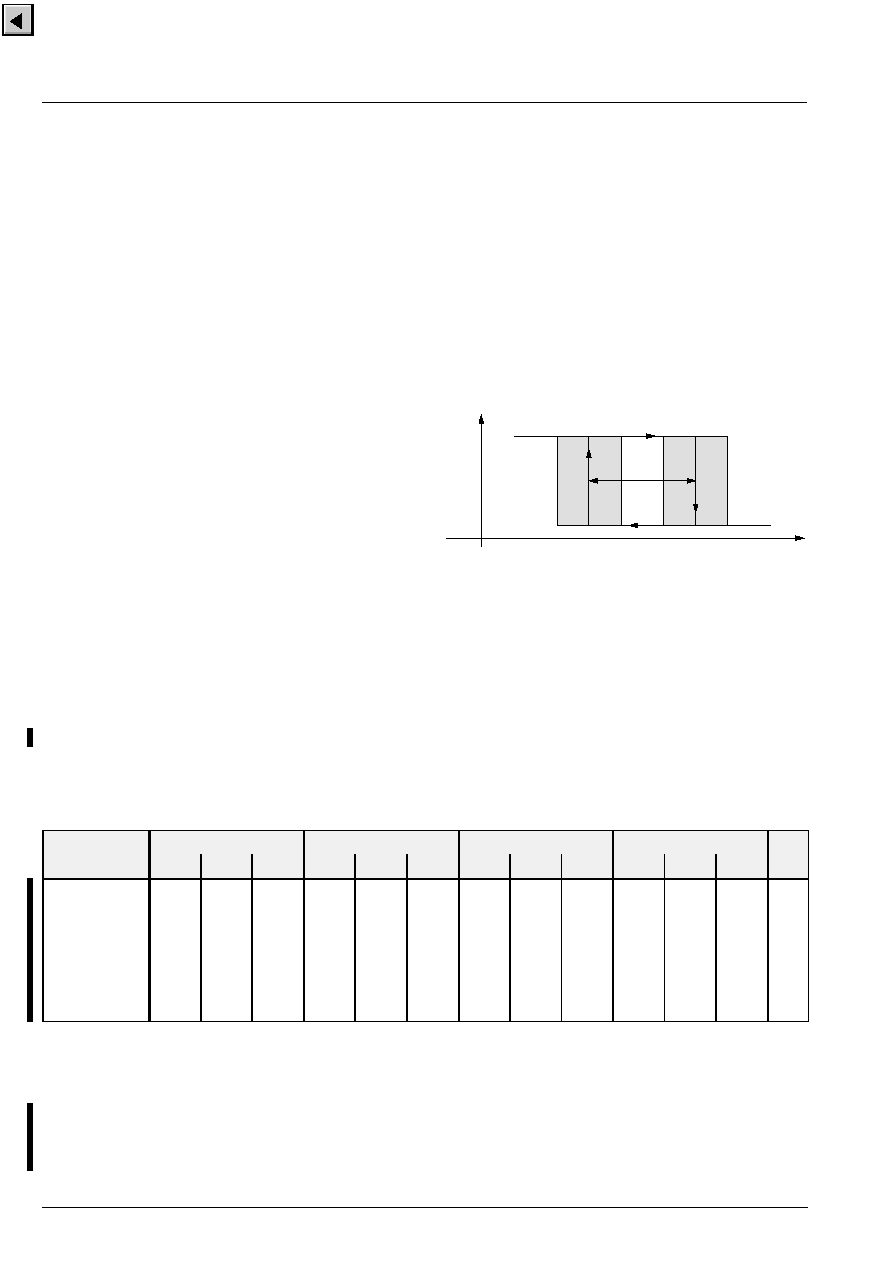
HAL560
14
Micronas
4.2. HAL 560
The HAL 560 is a low sensitive unipolar switching sensor
with an inverted output (see Fig. 4≠5).
The sensor turns to low current consumption with the
magnetic south pole on the branded side of the package
and turns to high current consumption if the magnetic
field is removed. It does not respond to the magnetic
north pole on the branded side.
For correct functioning in the application, the sensor re-
quires only the magnetic south pole on the branded side
of the package.
Magnetic Features:
≠ switching type: unipolar inverted
≠ low sensitivity
≠ typical B
ON
: 45.6 mT at room temperature
≠ typical B
OFF
: 51.7 mT at room temperature
≠ operates with static magnetic fields and dynamic mag-
netic fields up to 10 kHz
Applications
The HAL 560 is designed for applications with one mag-
netic polarity and strong magnetic amplitudes at the sen-
sor position where an inverted output signal is required
such as:
≠ applications with strong magnets,
≠ solid state switches,
≠ contactless solutions to replace micro switches,
≠ position and end point detection, and
≠ rotating speed measurement.
B
HYS
0
B
OFF
B
ON
B
Fig. 4≠5: Definition of magnetic switching points for
the HAL 560
I
DDhigh
I
DDlow
Current consumption
Magnetic Characteristics at T
J
= ≠40
∞
C to +170
∞
C, V
DD
= 4 V to 24 V,
Typical Characteristics for V
DD
= 12 V
Magnetic flux density values of switching points.
Positive flux density values refer to the magnetic south pole at the branded side of the package.
Parameter
On point B
ON
Off point B
OFF
Hysteresis B
HYS
Magnetic Offset
Unit
T
J
Min.
Typ.
Max.
Min.
Typ.
Max.
Min.
Typ.
Max.
Min.
Typ.
Max.
≠40
∞
C
41
46.5
52
47
53
59
4
6.5
10
49.8
mT
25
∞
C
41
46.5
52
46
52.5
58.5
3
6
9
49.5
mT
100
∞
C
41
45.7
52
45
51.1
57.5
2
5.4
8
48.4
mT
140
∞
C
39
44.8
51
43.5
49.8
56.5
2
5
8
47.3
mT
170
∞
C
38
44.2
50
42
49
55.5
2
4.8
8
46.6
mT
The hysteresis is the difference between the switching points B
HYS
= B
OFF
≠ B
ON
The magnetic offset is the mean value of the switching points B
OFFSET
= (B
ON
+ B
OFF
) / 2
Changes to the previous edition:
≠ tighter specification for B
OFF
at ≠40
∞
C, 25
∞
C, and 100
∞
C
≠ specification for 140
∞
C and 170
∞
C added
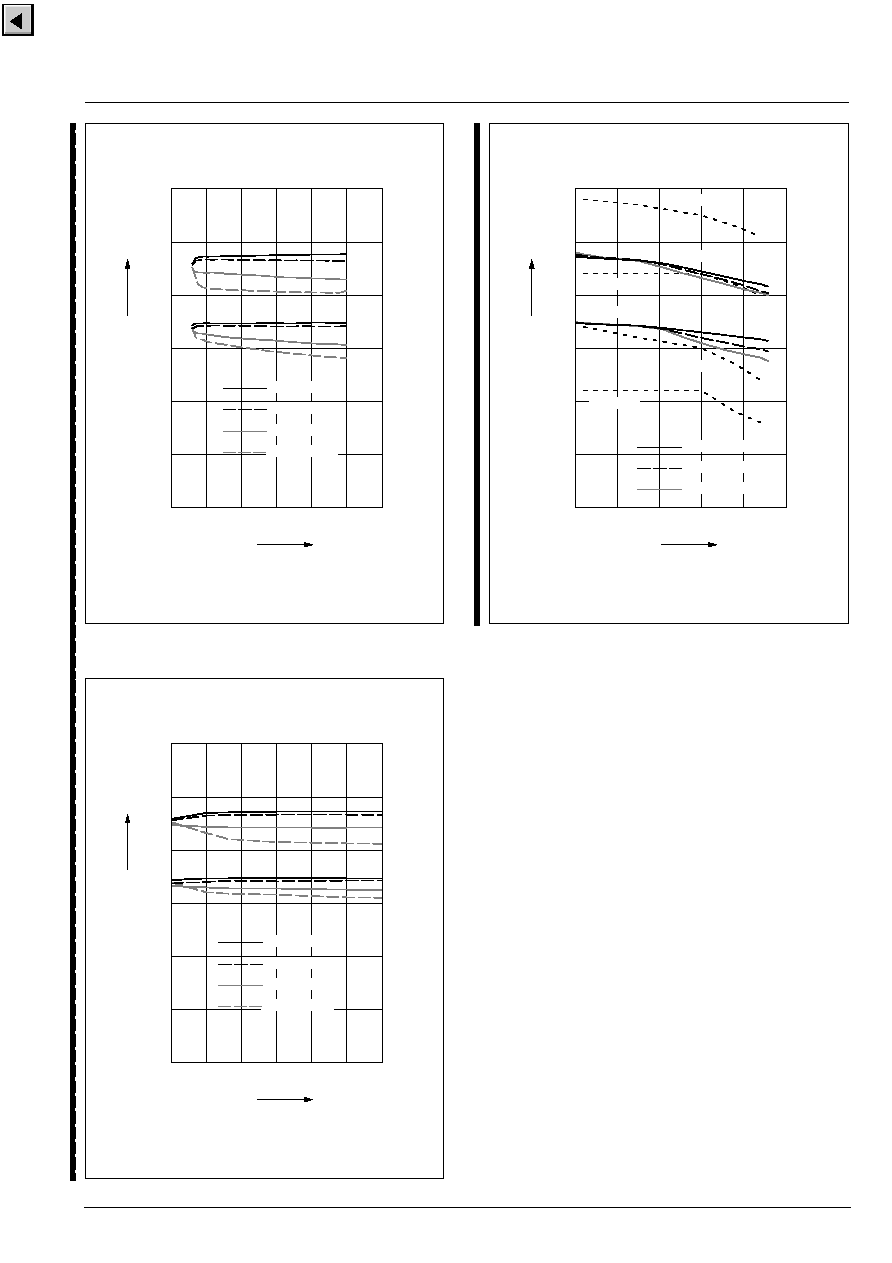
HAL560
15
Micronas
30
35
40
45
50
55
60
0
5
10
15
20
25
30 V
mT
V
DD
B
ON
B
OFF
HAL 560
B
ON
B
OFF
Fig. 4≠6: Typ. magnetic switching points
versus supply voltage
T
A
= ≠40
∞
C
T
A
= 25
∞
C
T
A
= 100
∞
C
T
A
= 170
∞
C
30
35
40
45
50
55
60
3
3.5
4.0
4.5
5.0
5.5
6.0 V
mT
V
DD
B
ON
B
OFF
HAL 560
B
ON
B
OFF
Fig. 4≠7: Typ. magnetic switching points
versus supply voltage
T
A
= ≠40
∞
C
T
A
= 25
∞
C
T
A
= 100
∞
C
T
A
= 170
∞
C
30
35
40
45
50
55
60
≠50
0
50
100
150
200
∞
C
mT
T
A
, T
J
B
ON
B
OFF
B
ON
max
B
ON
typ
B
ON
min
B
OFF
max
B
OFF
typ
B
OFF
min
HAL 560
Fig. 4≠8: Magnetic switching points
versus temperature
V
DD
= 4 V
V
DD
= 12 V
V
DD
= 24 V
Note: In the diagram "Magnetic switching points versus
temperature" the curves for B
ON
min, B
ON
max,
B
OFF
min, and B
OFF
max refer to junction temperature,
whereas typical curves refer to ambient temperature.
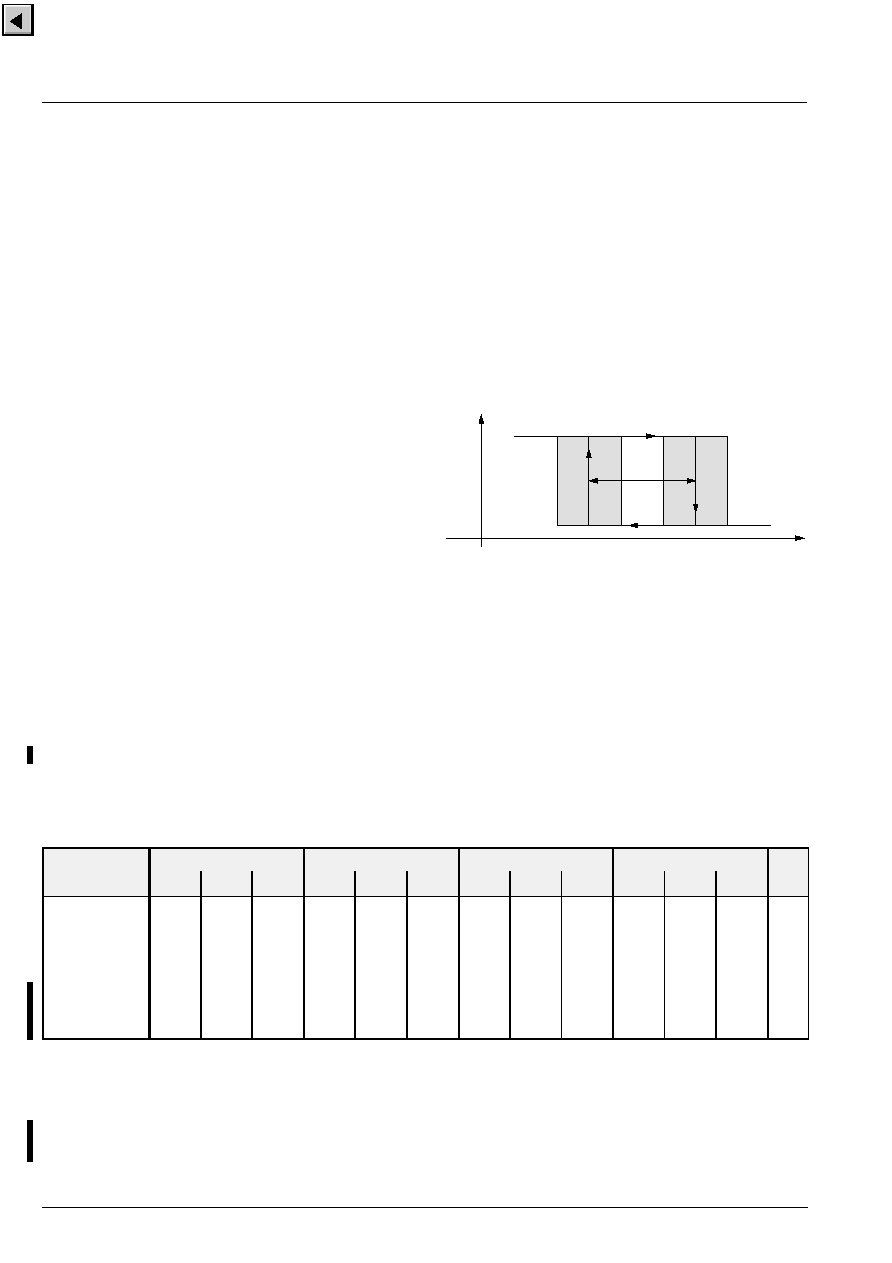
HAL566
16
Micronas
4.3. HAL 566
The HAL 566 is a very sensitive unipolar switching
sensor with an inverted output (see Fig. 4≠9).
The sensor turns to low current consumption with the
magnetic south pole on the branded side of the package
and turns to high current consumption if the magnetic
field is removed. It does not respond to the magnetic
north pole on the branded side.
For correct functioning in the application, the sensor re-
quires only the magnetic south pole on the branded side
of the package.
In the HAL 55x, HAL 56x two-wire sensor family, the
HAL 556 is a sensor with the same magnetic character-
istics but with a normal output characteristic.
Magnetic Features:
≠ switching type: unipolar inverted
≠ high sensitivity
≠ typical B
ON
: 4 mT at room temperature
≠ typical B
OFF
: 5.9 mT at room temperature
≠ operates with static magnetic fields and dynamic mag-
netic fields up to 10 kHz
Applications
The HAL 566 is designed for applications with one mag-
netic polarity and weak magnetic amplitudes at the sen-
sor position where an inverted output signal is required
such as:
≠ applications with large airgap or weak magnets,
≠ solid state switches,
≠ contactless solutions to replace micro switches,
≠ position and end point detection, and
≠ rotating speed measurement.
B
HYS
0
B
OFF
B
ON
B
Fig. 4≠9: Definition of magnetic switching points for
the HAL 566
I
DDhigh
I
DDlow
Current consumption
Magnetic Characteristics at T
J
= ≠40
∞
C to +170
∞
C, V
DD
= 4 V to 24 V,
Typical Characteristics for V
DD
= 12 V
Magnetic flux density values of switching points.
Positive flux density values refer to the magnetic south pole at the branded side of the package.
Parameter
On point B
ON
Off point B
OFF
Hysteresis B
HYS
Magnetic Offset
Unit
T
J
Min.
Typ.
Max.
Min.
Typ.
Max.
Min.
Typ.
Max.
Min.
Typ.
Max.
≠40
∞
C
2.1
4
5.9
3.4
6
7.7
0.8
2
2.8
5
mT
25
∞
C
2
3.9
5.7
3.4
5.9
7.2
0.5
2
2.7
3
4.9
6.2
mT
100
∞
C
1.85
3.8
5.7
3.25
5.6
7
0.3
1.8
2.6
4.7
mT
140
∞
C
1.3
3.6
6
2.6
5.2
7.3
0.2
1.6
3
4.4
mT
170
∞
C
1
3.4
6.3
2.2
4.8
7.6
0.2
1.4
3
4.1
mT
The hysteresis is the difference between the switching points B
HYS
= B
OFF
≠ B
ON
The magnetic offset is the mean value of the switching points B
OFFSET
= (B
ON
+ B
OFF
) / 2
Changes to the previous edition:
≠ specification for 140
∞
C and 170
∞
C added

HAL566
17
Micronas
0
1
2
3
4
5
6
7
8
0
5
10
15
20
25
30 V
mT
V
DD
B
ON
B
OFF
HAL 566
B
OFF
Fig. 4≠10: Typ. magnetic switching points
versus supply voltage
B
ON
T
A
= ≠40
∞
C
T
A
= 25
∞
C
T
A
= 100
∞
C
T
A
= 170
∞
C
0
1
2
3
4
5
6
7
8
3
3.5
4.0
4.5
5.0
5.5
6.0 V
mT
V
DD
B
ON
B
OFF
HAL 566
B
OFF
Fig. 4≠11: Typ. magnetic switching points
versus supply voltage
B
ON
T
A
= ≠40
∞
C
T
A
= 25
∞
C
T
A
= 100
∞
C
T
A
= 170
∞
C
0
1
2
3
4
5
6
7
8
≠50
0
50
100
150
200
∞
C
mT
T
A
, T
J
B
ON
B
OFF
B
ON
max
B
ON
typ
B
ON
min
B
OFF
max
B
OFF
typ
B
OFF
min
HAL 566
Fig. 4≠12: Magnetic switching points
versus temperature
V
DD
= 4 V
V
DD
= 12 V
V
DD
= 24 V
Note: In the diagram "Magnetic switching points versus
temperature" the curves for B
ON
min, B
ON
max,
B
OFF
min, and B
OFF
max refer to junction temperature,
whereas typical curves refer to ambient temperature.
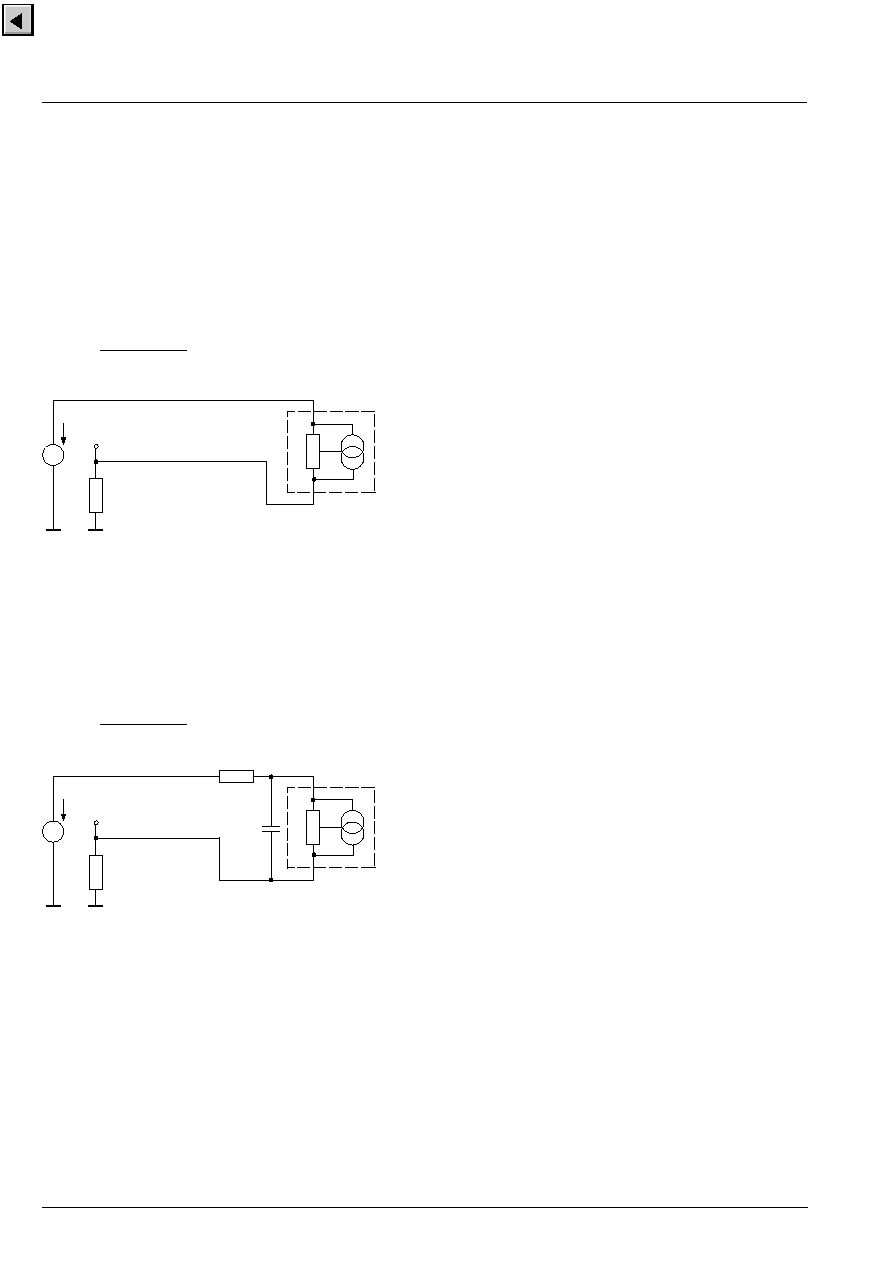
HAL55x, HAL56x
18
Micronas
5. Application Notes
5.1. Application Circuit
Figure 5≠1 shows a simple application with a two-wire
sensor. The current consumption can be detected by
measuring the voltage over R
L
. For correct functioning
of the sensor, the voltage between pin 1 and 2 (V
DD
)
must be a minimum of 4 V. With the maximum current
consumption of 17 mA, the maximum R
L
can be calcu-
lated as:
R
Lmax
+
V
SUPmin
*
4 V
17 mA
V
SUP
R
L
1 V
DD
GND
2
V
SIG
Fig. 5≠1: Application Circuit 1
For applications with disturbances on the supply line or
radiated disturbances, a series resistor R
V
(ranging from
10
to 30
)
and a capacitor both placed close to the
sensor are recommended (see figure 5≠2). In this case,
the maximum R
L
can be calculated as:
R
Lmax
+
V
SUPmin
*
4 V
17 mA
*
R
V
1 V
DD
GND
2
Fig. 5≠2: Application Circuit 2
4.7 nF
R
V
V
SUP
R
L
V
SIG
5.2. Extended Operating Conditions
All sensors fulfill the electrical and magnetic characteris-
tics when operated within the Recommended Operating
Conditions (see page 7).
Typically, the sensors operate with supply voltages
above 3 V. However, below 4 V, the current consumption
and the magnetic characteristics may be outside the
specification.
Note: The functionality of the sensor below 4 V is not
tested on a regular base. For special test conditions,
please contact Micronas.
5.3. Start-up Behavior
Due to the active offset compensation, the sensors have
an initialization time (enable time t
en(O)
) after applying
the supply voltage. The parameter t
en(O)
is specified in
the Electrical Characteristics (see page 8). During the
initialization time, the current consumption is not defined
and can toggle between low and high.
HAL 556:
After t
en(O)
, the current consumption will be high if the
applied magnetic field B is above B
ON
. The current con-
sumption will be low if B is below B
OFF
.
HAL 560, HAL 566:
In case of sensors with an inverted switching behavior,
the current consumption will be low if B > B
OFF
and high
if B < B
ON
.
Note: For magnetic fields between B
OFF
and B
ON
, the
current consumption of the HAL sensor will be either low
or high after applying V
DD
. In order to achieve a defined
current consumption, the applied magnetic field must be
above B
ON
, respectively, below B
OFF
.

HAL55x, HAL56x
19
Micronas
5.4. Ambient Temperature
Due to internal power dissipation, the temperature on
the silicon chip (junction temperature T
J
) is higher than
the temperature outside the package (ambient tempera-
ture T
A
).
T
J
= T
A
+
T
At static conditions and continuous operation, the follow-
ing equation is valid:
T = I
DD
* V
DD
* R
th
For all sensors, the junction temperature range T
J
is
specified. The maximum ambient temperature T
Amax
can be calculated as:
T
Amax
= T
Jmax
≠
T
For typical values, use the typical parameters. For worst
case calculation, use the max. parameters for I
DD
and
R
th
, and the max. value for V
DD
from the application.
Due to the range of I
DDhigh
, self-heating can be critical.
The junction temperature can be reduced with pulsed
supply voltage. For supply times (t
on
) ranging from 30
µ
s
to 1 ms, the following equation can be used:
D
T
+
I
DD
* V
DD
* R
th
*
t
on
t
off
)
t
on
5.5. EMC and ESD
For applications with disturbances on the supply line or
radiated disturbances, a series resistor and a capacitor
are recommended (see Fig. 5≠2). The series resistor
and the capacitor should be placed as closely as pos-
sible to the HAL sensor.
Applications with this arrangement passed the EMC
tests according to the product standards DIN 40839.
Note: The international standard ISO 7637 is similar to
the product standard DIN 40839.
Please contact Micronas for the detailed investigation
reports with the EMC and ESD results.
4.7 nF
V
EMC
R
V1
100
GND
2
1 V
DD
NC
R
V2
30
Fig. 5≠3: Recommended EMC test circuit

HAL55x, HAL56x
20
Micronas
6. Data Sheet History
1. Final data sheet: "HAL 556, HAL 560, HAL 566, Two-
Wire Hall Effect Sensor Family, April 6, 1999,
6251-425-1DS. First release of the final data sheet.
2 Final data sheet: "HAL 556, HAL 560, HAL 566, Two-
Wire Hall Effect Sensor Family, Aug. 3, 2000,
6251-425-2DS. Second release of the final data
sheet. Major changes:
≠ magnetic characteristics for HAL 556 and HAL 560
changed. Please refer to pages 12 and 14 for details.
≠ new temperature ranges "K" and "A" added
≠ temperature range "C" removed
≠ outline dimensions for SOT-89B: reduced toler-
ances
≠ SMD package SOT-89A removed
Micronas GmbH
Hans-Bunte-Strasse 19
D-79108 Freiburg (Germany)
P.O. Box 840
D-79008 Freiburg (Germany)
Tel. +49-761-517-0
Fax +49-761-517-2174
E-mail: docservice@micronas.com
Internet: www.micronas.com
Printed in Germany
by Systemdruck+Verlags-GmbH, Freiburg (08/2000)
Order No. 6251-425-2DS
All information and data contained in this data sheet are without any
commitment, are not to be considered as an offer for conclusion of a
contract, nor shall they be construed as to create any liability. Any new
issue of this data sheet invalidates previous issues. Product availability
and delivery are exclusively subject to our respective order confirma-
tion form; the same applies to orders based on development samples
delivered. By this publication, Micronas GmbH does not assume re-
sponsibility for patent infringements or other rights of third parties
which may result from its use.
Further, Micronas GmbH reserves the right to revise this publication
and to make changes to its content, at any time, without obligation to
notify any person or entity of such revisions or changes.
No part of this publication may be reproduced, photocopied, stored on
a retrieval system, or transmitted without the express written consent
of Micronas GmbH.

Micronas
page 1 of 1
Subject:
Data Sheet Concerned:
Supplement:
Edition:
Data Sheet Supplement
Changes:
≠ position tolerance of the sensitive area reduced
≠ tolerances of the outline dimensions reduced
≠ thickness of the leadframe changed to 0.15 mm (old 0.125 mm)
≠ SOT-89A will be discontinued in December 2000
Position of sensitive area
Note: A mechanical tolerance of
±
0.05 mm applies to all dimensions where no tolerance is explicitly given.
Position tolerance of the sensitive area is defined in the package diagram.
HAL 114, 115
HAL 50x, 51x
HAL 621, 629
HAL 55x, HAL 56x
x
center of the package
center of the package
y
0.95 mm nominal
0.85
mm nominal
min.
0.25
2.55
0.4
0.4
0.4
1.5
3.0
0.06
±
0.04
branded side
SPGS0022-5-A3/2E
y
1
2
3
4
±
0.2
0.15
0.3
4.55
1.7
2
0.2
sensitive area
top view
1.15
Improvement of SOT-89B Package
HAL 114, 115, 6251-456-2DS, Dec. 20, 1999
HAL 50x, 51x, 6251-485-1DS, Feb. 16, 1999
HAL 55x, 56x, 6251-425-1DS, April 6, 1999
HAL 621, 629, 6251-504-1DS, Feb. 3, 2000
No. 1/ 6251-531-1DSS
July 4, 2000
HAL 11x, HAL 5xx, HAL 62x




















